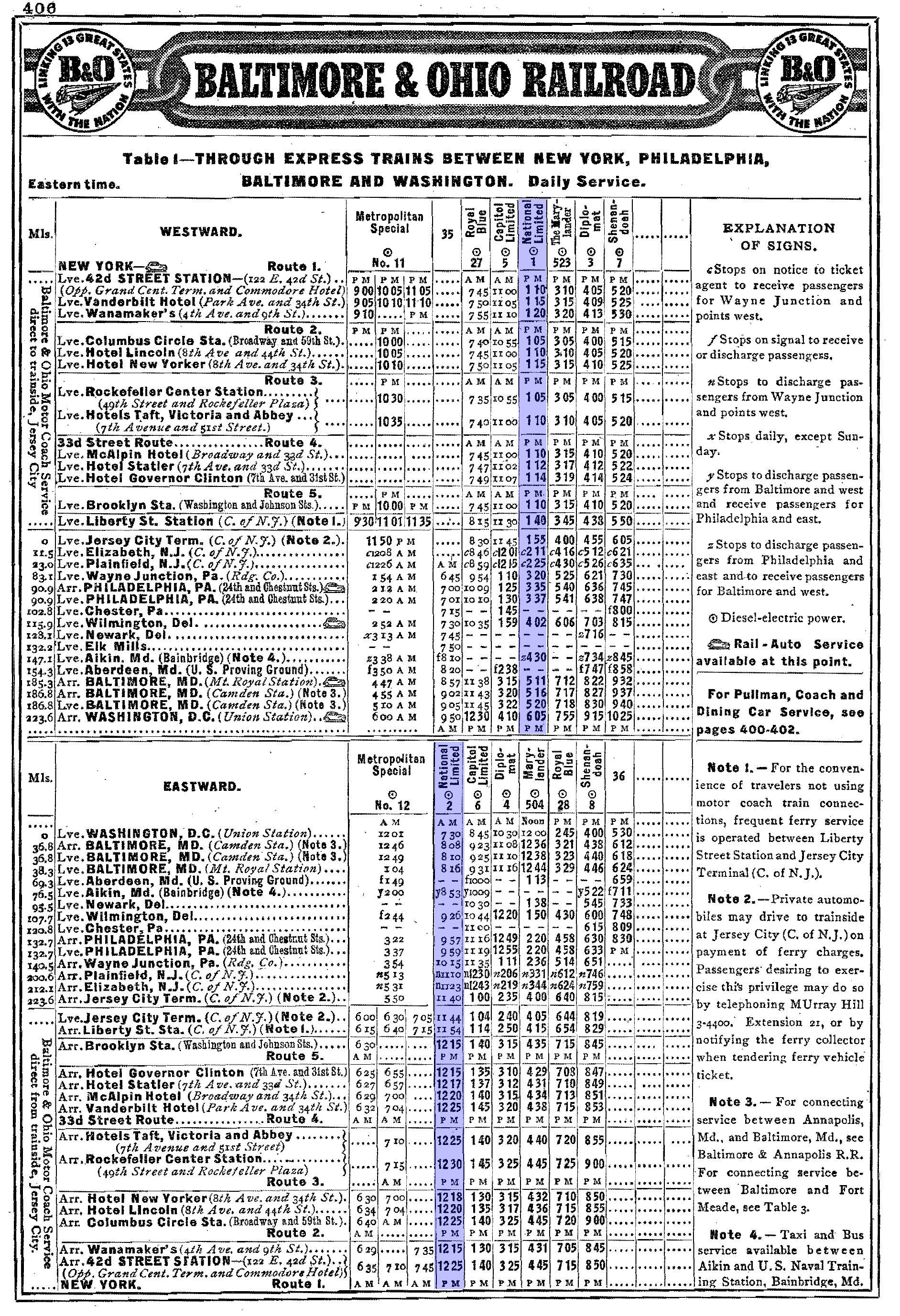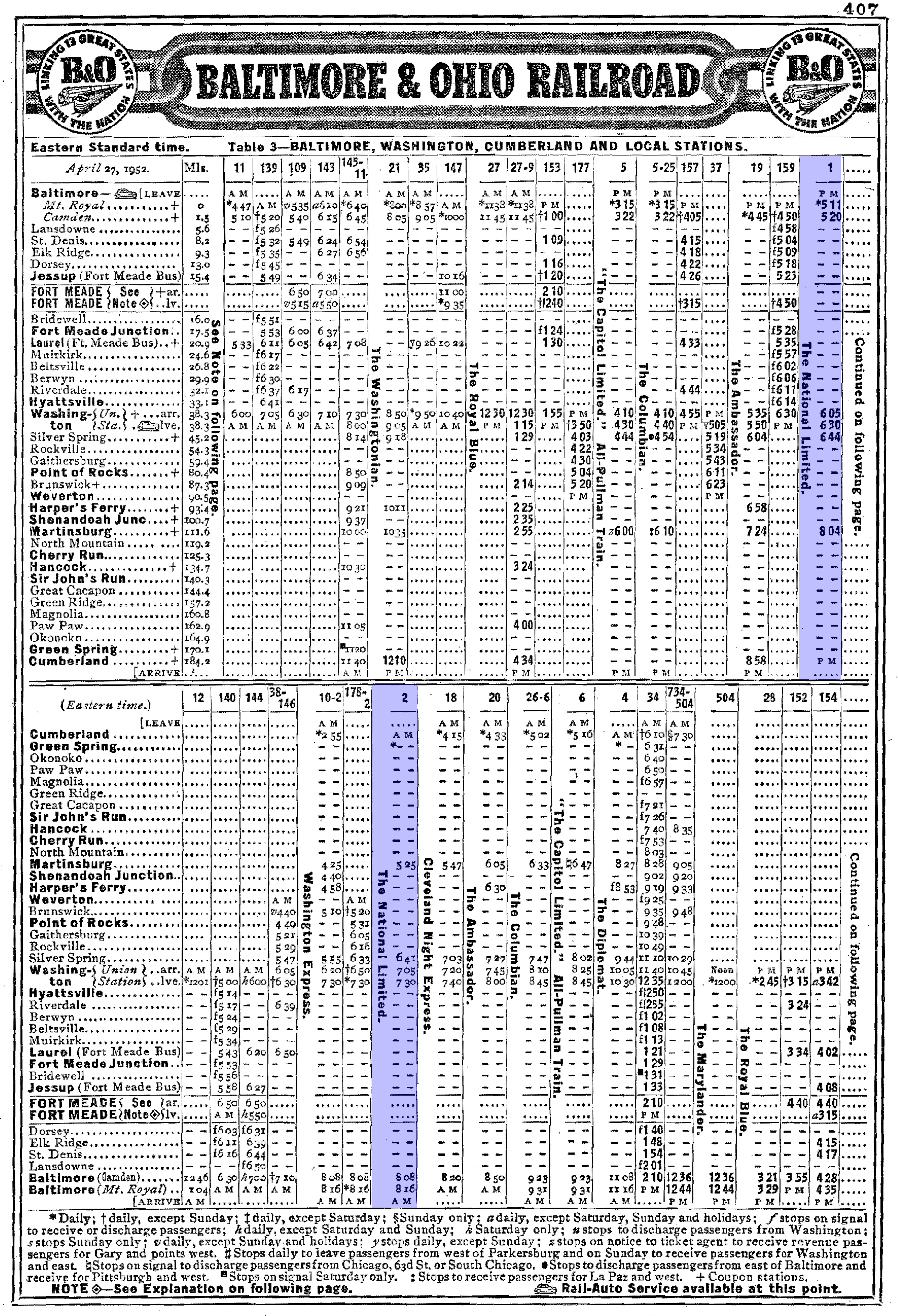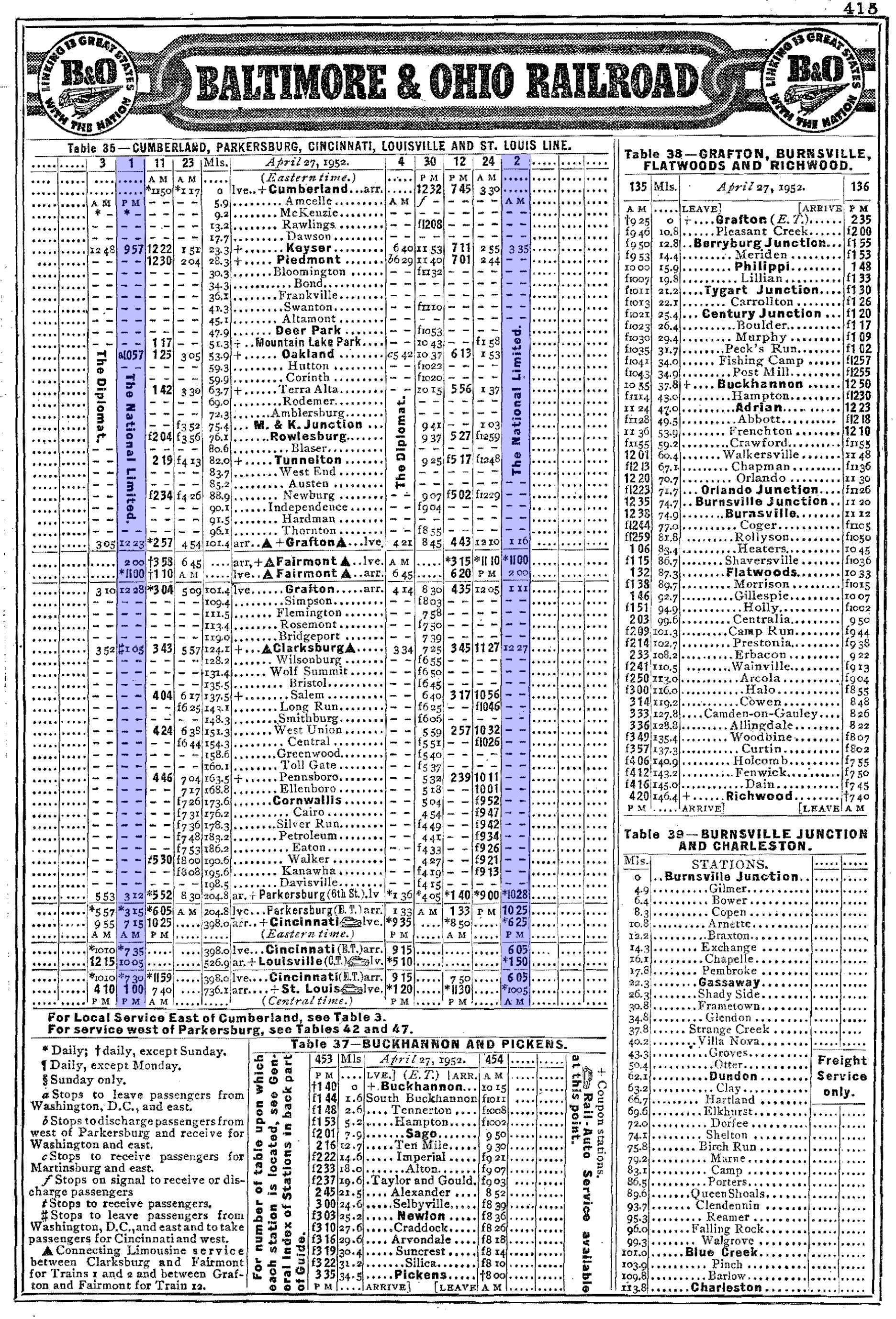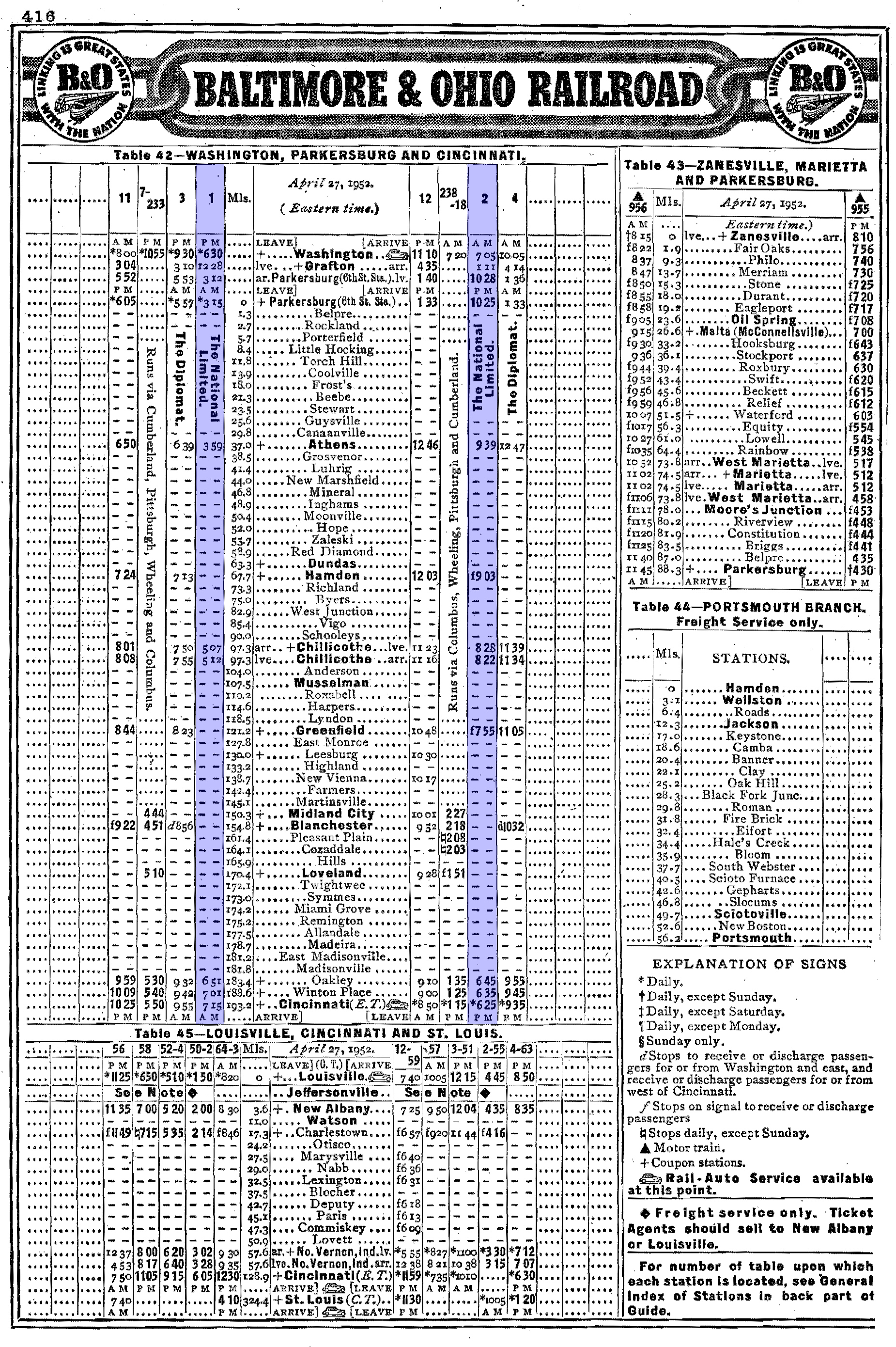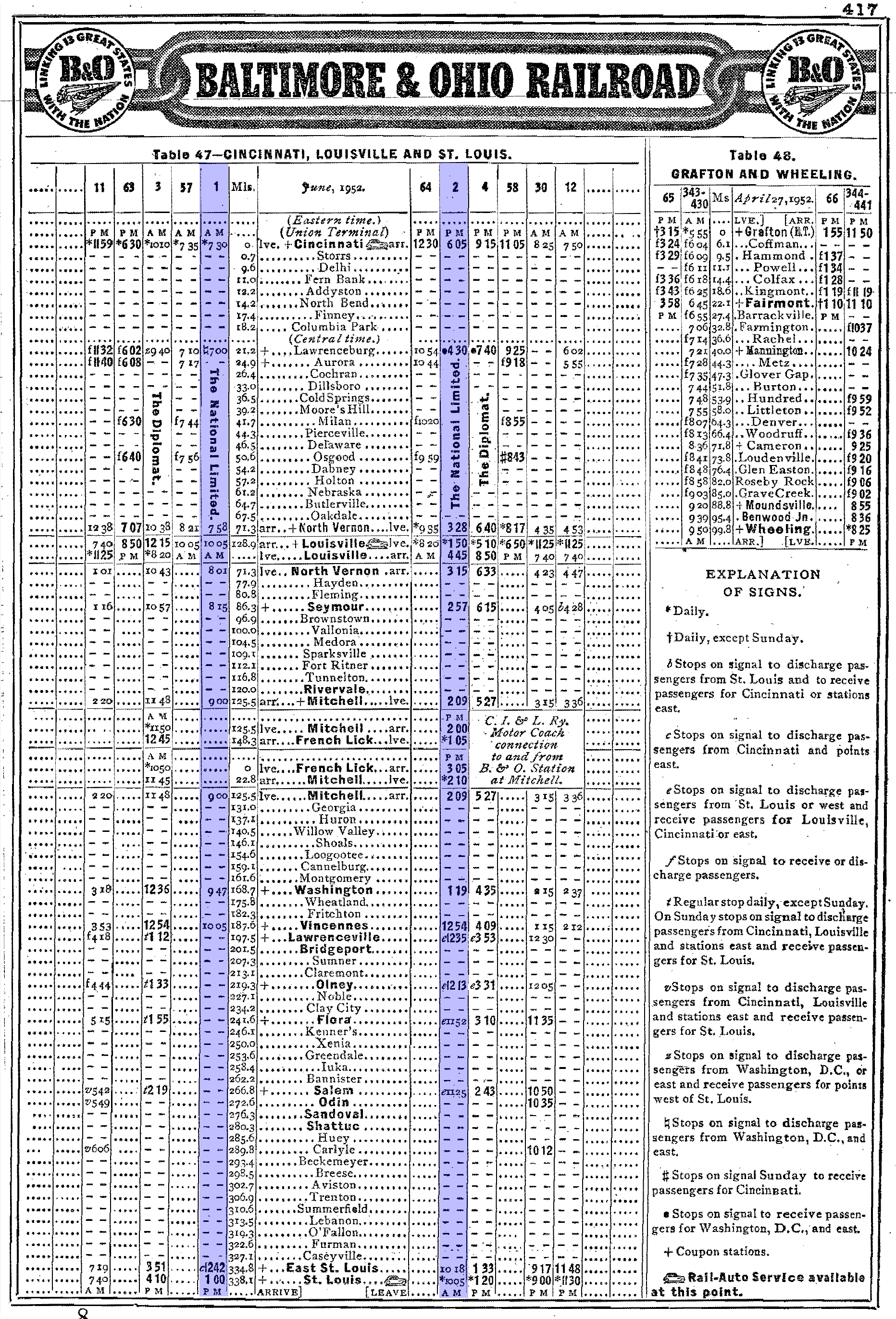"National Limited" (Train): Timetable, Route, Consist
Last revised: February 27, 2025
By: Adam Burns
Baltimore & Ohio’s National Limited was the railroad’s premier train to St. Louis. Until 1958 it provided travelers with a New York City connection. However, after ceding this market to the PRR that spring service was truncated at Baltimore.
Despite declining patronage in the postwar years the National Limited remained one of the B&O's flagship runs throughout the 1950s. However, as demand continued to slump and the railroad facing potential bankruptcy the train as canceled in the mid-1960s.
Nevertheless, the B&O continued to provide service along the route via other trains until the start of Amtrak. Today, not only is the National a memory but also much of the route it plied through West Virginia and southern Ohio.
Photos
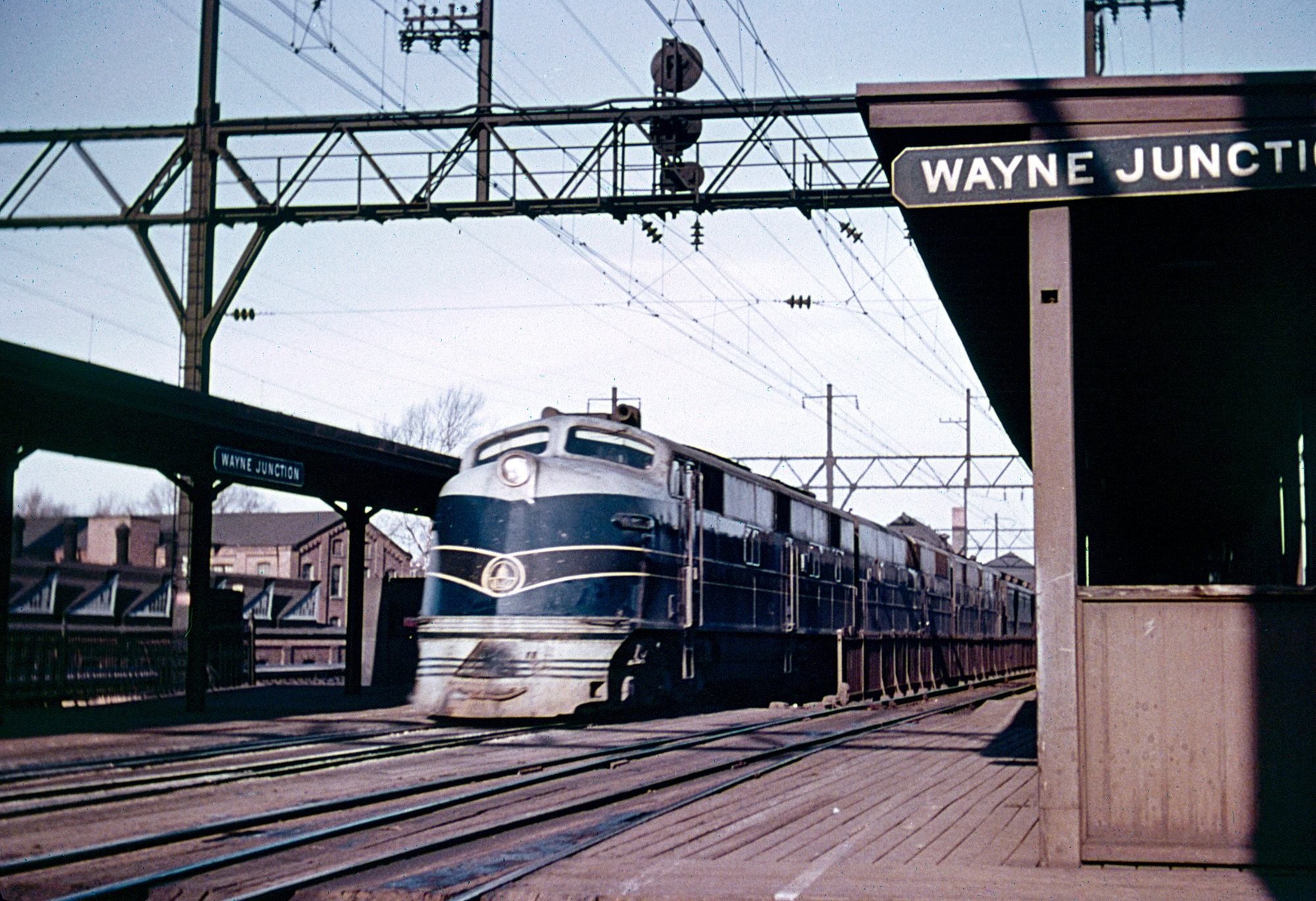 Baltimore & Ohio's train #1, the westbound "National Limited," has arrived at Wayne Junction, Pennsylvania (Philadelphia) in a scene from 1949. William Rinn photo. American-Rails.com collection.
Baltimore & Ohio's train #1, the westbound "National Limited," has arrived at Wayne Junction, Pennsylvania (Philadelphia) in a scene from 1949. William Rinn photo. American-Rails.com collection.History
The National Limited trace its heritage back to the 1910s although the train was not officially launched until April 26, 1925 when the B&O unveiled an all-Pullman heavyweight train between New York-St. Louis.
Listed as trains #1 and #2 on the B&O's timetable, the original routing left the Jersey Central's Jersey City Terminal, located along the Hudson River waterfront. From that point passengers boarded ferries and could reach a variety of points in downtown Manhattan.
If one took the train in its entirety you trip would conclude in St. Louis. It was in the late 1930s that the National truly came of age. During this time the B&O reequipped its most prestigious trains with Electro-Motive's brand new, self-contained streamlined diesel, the EA.
Not only was this locomotive sleek and gorgeous but the ever-resourceful B&O, not satisfied with the light-weight, aluminum cars it had purchased for its first streamliner, the Royal Blue, turned to its Mount Clare Shops for new equipment (a move made by famed company president Daniel Willard).
Consist (1952)
The forces there rebuilt traditional, heavyweight cars and gave them streamlining to match the EA sets. What resulted - with the help of renowned industrial designer Otto Kuhler - were two stunning trains featuring one of the industry's all-time classic liveries of royal blue, blue/grey, silver, and gold pin-striping.
Along with being entirely air-conditioned the train also featured a nine-car consist including; five sleepers, a sun-room/observation-lounge, diner, buffet/coach-lounge, and reclining-seat coach.
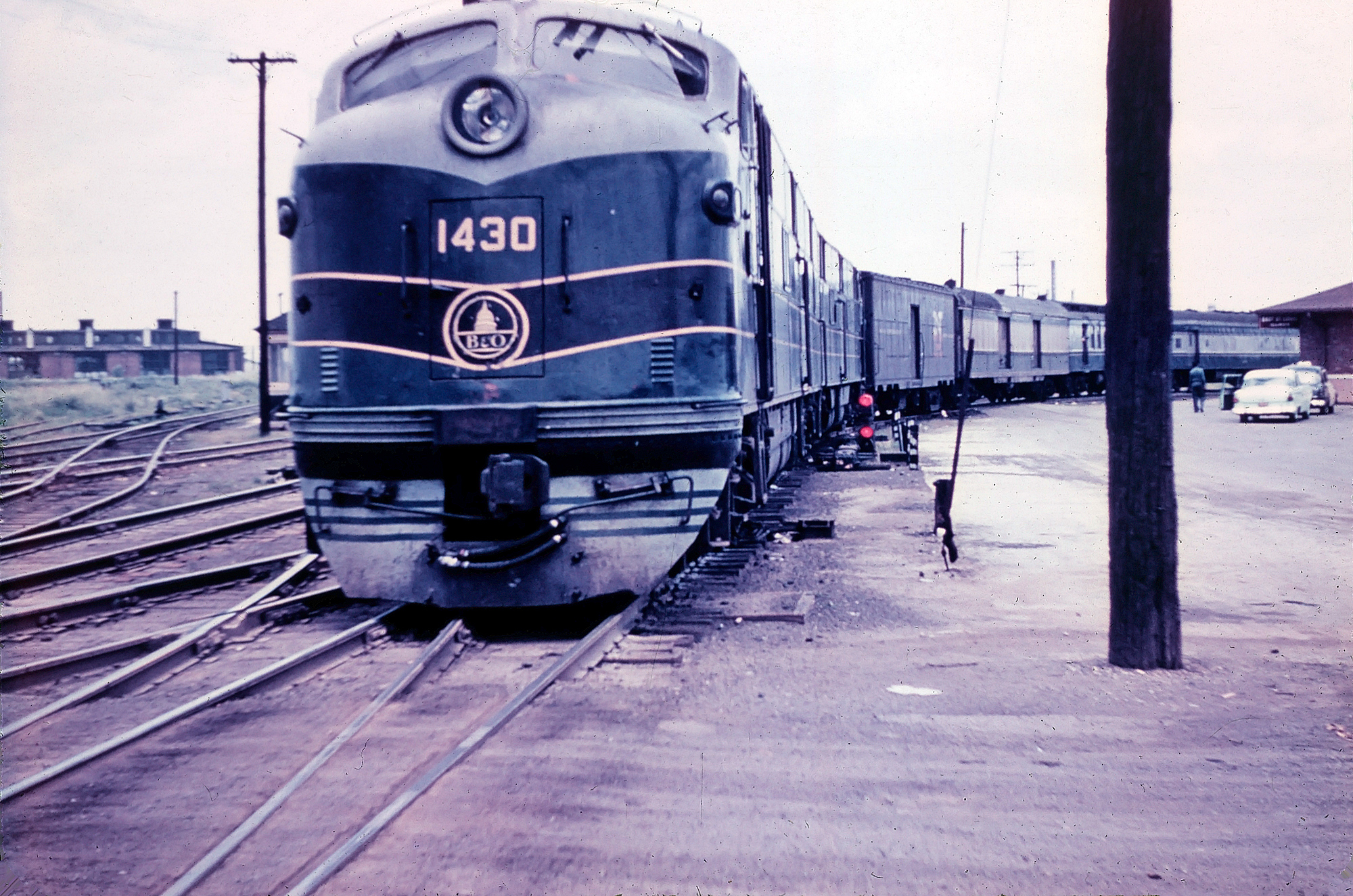 Baltimore & Ohio E7A #1430 is ahead of the "National Limited" at East St. Louis, Illinois on June 22, 1957. American-Rails.com collection.
Baltimore & Ohio E7A #1430 is ahead of the "National Limited" at East St. Louis, Illinois on June 22, 1957. American-Rails.com collection.The National Limited would later feature the first dome cars for an eastern railroad, the Strata-Dome. While the B&O won over the hearts of many with its splendid services and on board offerings it simply could not compete with the Pennsylvania and New York Central in the New York market.
Timetable (1952)
As a result on April 26, 1958 the B&O gave up on NYC, cutting all services back to Baltimore/D.C., which included both the National Limited and Capitol Limited.
As ridership continued to decline through the 1960s the St. Louis route was hit especially hard since it traveled through lightly populated areas of West Virginia and southern Ohio. During this time the train lost its all-Pullman status and in October of 1964 was renamed as simply the National.
Timetable (1941)
| Time/Leave (Train #1) | Milepost | Location | Time/Arrive (Train #2) |
|---|---|---|---|
| 1:35 PM (ET) | 0.0 | 12:39 PM (ET) | |
| 1:50 PM | 1.0 | 12:26 PM | |
| 2:06 PM | 12.5 | 12:10 PM | |
| 2:20 PM | 24.0 | 11:56 AM | |
| 3:19 PM | 84.1 | 10:57 AM | |
| 3:34 PM (Ar) 3:36 PM (Dp) | 91.9 | 10:41 AM | |
| 103.8 | 10:22 AM | ||
| 4:06 PM | 116.9 | 10:06 AM | |
| 129.1 | 9:52 AM | ||
| 5:21 PM | 186.3 | 8:50 AM | |
| 5:26 PM (Ar) 5:28 PM (Dp) | 187.8 | 8:44 AM (Dp) 8:42 AM (Ar) | |
| 6:13 PM (Ar) 6:30 PM (Dp) | 224.6 | 8:00 AM (Dp) 7:40 AM (Ar) | |
| 6:44 PM | 231.5 | 7:22 AM | |
| 8:04 PM | 298.0 | 6:00 AM | |
| 9:50 PM | 399.0 | 4:10 AM | |
| 10:50 PM | 429.6 | ||
| 12:16 AM (Ar) 12:21 AM (Dp) | 477.1 | 1:42 AM (Dp) 1:32 AM (Ar) | |
| 12:58 AM | 499.8 | 12:45 AM | |
| 3:05 AM (Ar) 3:08 AM (Dp) | 580.5 | 10:34 PM (Dp) 10:31 PM (Ar) | |
| 3:53 AM | 617.5 | 9:38 PM | |
| 648.2 | F 8:56 PM | ||
| 5:03 AM (Ar) 5:08 AM (Dp) | 677.8 | 8:19 PM (Dp) 8:12 PM (Ar) | |
| 707.7 | 7:44 PM | ||
| 6:51 AM | 763.9 | 6:25 PM | |
| 7:00 AM | 769.1 | 6:14 PM | |
| 7:15 AM (Ar) 7:25 AM (Dp) | 773.7 | 6:05 PM (Dp) 5:50 PM (Ar) | |
| 6:56 AM (CT) | 794.9 | 4:15 PM (CT) | |
| 7:56 AM (Ar) 8:00 AM (Dp) | 845.0 | 3:10 PM (Dp) 3:02 PM (Ar) | |
| 8:17 AM | 860.0 | 2:44 PM | |
| 9:05 AM | 899.2 | 1:56 PM | |
| 9:55 AM | 942.4 | 1:00 PM | |
| 10:20 AM | 961.3 | 12:26 PM | |
| 971.2 | F 12:10 PM | ||
| 993.0 | F 11:43 AM | ||
| 1015.3 | F 11:20 AM | ||
| 1040.5 | F 10:55 AM | ||
| F 12:55 PM | 1108.5 | 9:43 AM | |
| 1:12 PM | 1111.8 | 9:30 AM |
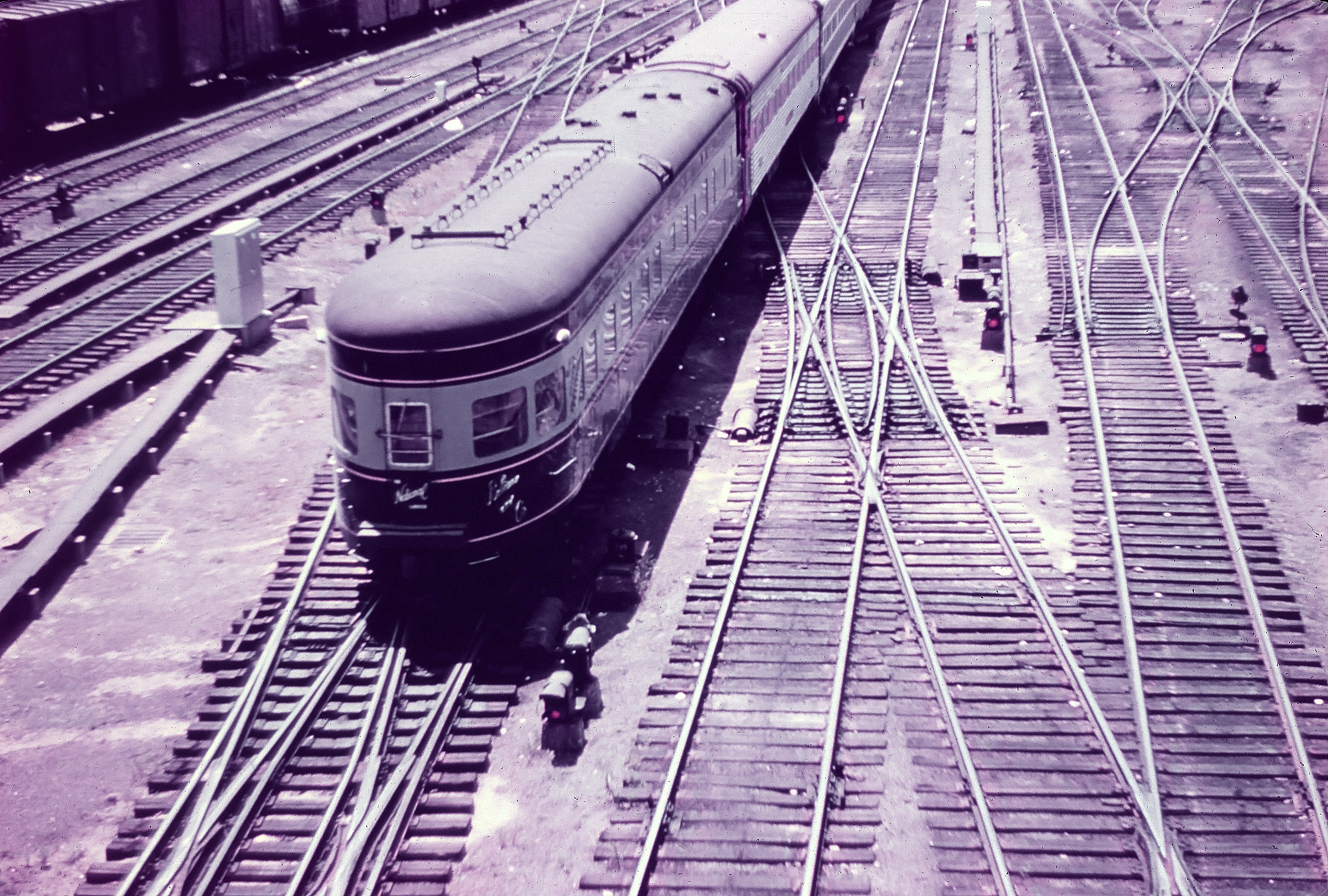 Baltimore & Ohio's westbound "National Limited" backs into St. Louis Union Station, circa 1957. Pictured is one of the B&O's three sleeper-buffet-lounge round-end observations (named "Genesee River," "Maumee River" and "Wabash River") purchased from the New York Central in 1956. American-Rails.com collection.
Baltimore & Ohio's westbound "National Limited" backs into St. Louis Union Station, circa 1957. Pictured is one of the B&O's three sleeper-buffet-lounge round-end observations (named "Genesee River," "Maumee River" and "Wabash River") purchased from the New York Central in 1956. American-Rails.com collection.Final Years
A year later the B&O gave up on the service altogether when its equipment was transferred to the new owner, Chesapeake & Ohio's George Washington, in September of 1965.
Despite the National's loss the B&O continued to maintain service along the route via the Metropolitan. Listed as trains #11 and #12 the train was not much more than a glorified commuter operation during its final years, usually carrying only a few reclining-seat coaches and no food service.
Naturally, when Amtrak began operations on May 1, 1971 it did not include the original route within its system although the name would return to the carrier's timetable for nearly a decade.
Amtrak
Under Amtrak the National Limited was a long-distance service connecting New York City and Kansas City, and resembled nothing of its historical predecessor. The reincarnated version was a renaming of the old PRR/Penn Central Spirit of St. Louis, with the name change occurring in July, 1971.
As such, this National Limited utilized the Penn Central with its connection to Kansas City operating over the Missouri Pacific. The train covered a distance of approximately 1,322 miles.
From its inception, Amtrak's version suffered from delays and slow running times due to Penn Central's decaying network as the conglomerate had filed for bankruptcy in June, 1970.
At inception, the train was numbered 30 for its eastbound service and 31 for westbound. Over the years, the numbers frequently changed. Its final incarnations, just before ending the service, were trains 40 and 41.
Though the National Limited ceased its operations more than four decades ago, its legacy remains preserved in the annals of rail history. It is remembered as a symbol of the early days of Amtrak, offering travelers an essential route across the United States.
Today, while several of its stops are still serviced by other Amtrak trains, no single service spans its entire original route.
Interestingly, this National Limited's route famously ran through the "Horseshoe Curve," an internationally renowned landmark near Altoona, Pennsylvania. This sharpest of turns offered passengers a unique and thrilling riding experience.
The train operated daily, providing a key transport link for regular commuters and leisure travelers. With service spanning across multiple states, the train connected communities and pioneered providing long-haul passenger service under Amtrak's umbrella.
Boarding the train was more than just a means to a destination; it was an engagement with the history and landscape of America. It’s overnight journey became a favorite for those who enjoyed the romance and adventure of train travel.
The National Limited's ultimate discontinuation was a part of the Amtrak's network overhaul due to funding cuts, which targeted several routes for elimination. Its final run was on October 1, 1979.
Sources
- Reynolds, Kirk and Oroszi, David. Baltimore & Ohio Railroad. Osceola: MBI Publishing, 2000.
- Schafer, Mike and Welsh, Joe. Streamliners, History of a Railroad Icon. St. Paul: MBI Publishing, 2003.
- Welsh, Joe. Baltimore & Ohio's Capitol Limited And National Limited. St. Paul: MBI Publishing, 2007.
Recent Articles
-
Rio Grande 2-8-2 Locomotives (K-37): Specs, Roster, Photos
Apr 15, 25 12:57 PM
Rio Grande's Class K-37 Mikes were itsdge steamers to enter service in the late 1920s. Today, all but two survive. -
Rio Grande 2-8-2 Locomotives (K-36): Specs, Roster, Photos
Apr 15, 25 11:09 AM
The Rio Grande's K-36 2-8-2s were its last new Mikados purchased for narrow-gauge use. Today, all but one survives. -
Rio Grande 2-8-2 Locomotives (Class K-28): Specs, Roster, Photos
Apr 14, 25 10:24 PM
Rio Grande's Class K-28 Mikados were its newest narrow-gauge steam locomotives since the Mudhens of the early 1900s. Today, three survive.

